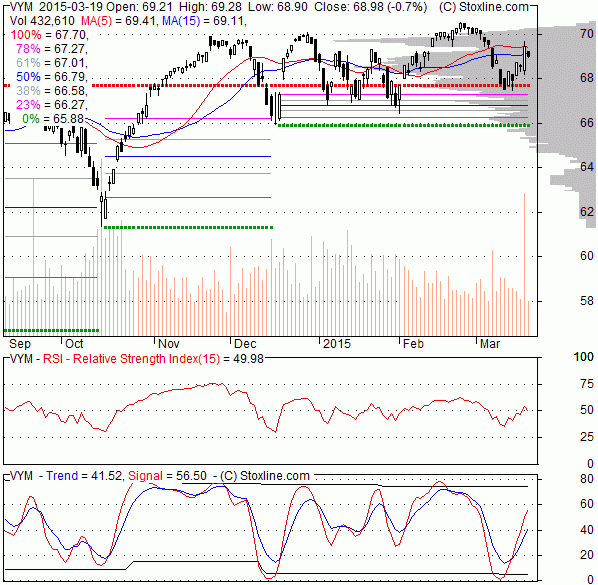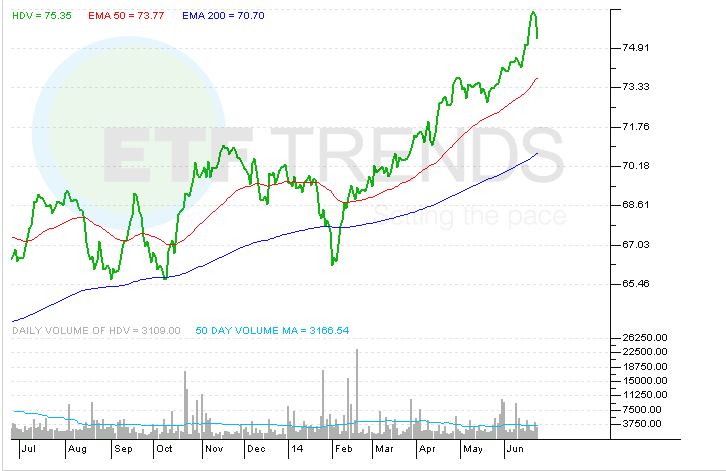The Vanguard High Dividend ETF Doesn t Play Well With Bears Vanguard High Dividend Yield ETF
Post on: 16 Март, 2015 No Comment

Summary
- VYM is a broadly diversified dividend ETF with a relatively high yield compared to similar funds.
- Aside from the 2008 financial crisis which hit all funds, VYM has consistently increased its dividends over time.
- The overall performance is strong, but historically, VYM has outperformed other dividend ETFs during bull markets and underperformed during bear markets.
Dividend ETFs are more popular than ever, thanks to the central banks of the world giving us zero interest rate policies (ZIRP), but the word dividend in an ETF means different things in different funds. Some funds target very high-yields, such as Global X SuperDividend ETF (NYSEARCA:SDIV ), but others such as Vanguard Dividend Appreciation ETF (NYSEARCA:VIG ) aim for growth, while WisdomTree has an entire lineup of ETFs that use dividends as a selection factor in their indexes. Investors benefit from having a wide range of choices among dividend funds, with sector and international exposure sliced and diced in many different ways. Picking the right fund for a portfolio can be a chore, though, since investors can dig through dozens of options.
Vanguard High Dividend Yield ETF (NYSEARCA:VYM ) was launched in 2006, and is the fourth-largest dividend ETF.
Index & Strategy
VYM tracks the FTSE High Yield Dividend Index. The index holds common stocks that can pay qualified dividends and are forecast to pay in the next 12 months. The index also bases stock selection on the projected dividend payout over the next year. This gives the fund a different outlook on the dividend space because it favors companies projected to see strong payout growth, which will often be those seeing strong earnings growth or improving financials.
Stocks are ranked by yield and added to the fund, weighted by market capitalization, until the market cap of the fund hits 50 percent of the total of all eligible funds. This method favors large caps.
As of September 30, the fund had 7.1 percent of assets in top holding Apple (NASDAQ:AAPL ), while number 10 holding Verizon (NYSE:VZ ) has 2.4 percent of assets. The fund has 392 holdings overall, with 36.1 percent of assets in the top 10.
Currently, the largest sector in the fund is technology, with 17.70 percent of assets, making it a well-balanced fund — and more balanced than the SPDR S&P 500 Trust ETF (NYSEARCA:SPY ), which has 19.30 percent in technology.
Performance
As discussed below, VYM has delivered consistent payout increases. Another Vanguard fund with a similar streak of rising payouts is Vanguard Dividend Appreciation. This chart is a price ratio of VYM to VIG (adjusted for dividends), and a rising line indicates VYM is outperforming.
The financial crisis in 2008 hit all funds very hard, but VIG held up very well relative to VYM. Since then, VYM has consistently outperformed.
VYM did even worse versus the SPDR S&P Dividend ETF (NYSEARCA:SDY ) in 2008, and didn’t stop underperforming SDY until late in 2010.
Here is VYM versus the iShares Select Dividend ETF (NYSEARCA:DVY ). DVY is tougher as a direct comparison, since it leans towards mid caps, but VYM actually holds up pretty well here.
As can be seen in all three charts, VYM again underperformed these three ETFs over the past few weeks. This shows VYM is likely to underperform again in the next bear market.
Finally, here is VYM versus SPY. The fund has done better during market declines, as would be expected from a dividend fund, but since its inception in late 2006, VYM has underperformed SPY.
Expenses

VYM has an expense ratio of 0.10 percent, placing it among the cheapest dividend ETFs.
Income
VYM had a 30-day SEC yield of 2.98 percent on October 16, 2014; it pays quarterly. This yield places VYM in the middle of the pack for dividend ETFs and relatively high for a fund that falls in the Giant Cap Value section of Morningstar’s Stylebox.
Dividends have been consistent and rising, except for the period from 2008 to 2010. Most funds suffered similarly in the wake of the financial crisis, but few of them bounced back as strongly as VYM.
Dividend growth has been solid as well, with growth slowing to below 10 percent only recently. Growth may continue to slow, given that the bull market is long in the tooth and earnings growth is unlikely to be as rapid as in the immediate post-crisis period. However, compared to other dividend ETFs, VYM should be among the faster income growers.
Risk & Reward
VYM has a beta of 0.85 versus the S&P 500 Index over the past 5 years. It has a standard deviation of 11.64 versus 13.20 for the S&P 500 Index. There is some variation with VIG and SDY, but these three funds are similar in that they’re all less volatile than the broader market.
VYM looks like it will underperform during a major market sell-off. It did so in 2008, and it did again in the past few weeks. Once a bear market has ended, VYM has been a great choice for buy-and-hold.
As with all dividend stocks and ETFs, rising interest rates could weigh on returns.
VYM has seen strong payout growth. Many dividend funds lack growth and/or consistency in their payouts. VYM has seen consistent increases, 2008-2010 aside. This makes it a solid choice for investors who want rising dividends.
VYM also yields more than VIG or SDY, making it one of the highest-yielding large cap dividend ETFs. Investors who want more of their returns in cash, rather than capital gains, should consider VYM.
Conclusion
The past couple of weeks have been useful for evaluating VYM. The underperformance in 2008 doesn’t appear to be a fluke, and investors can reasonably expect underperformance in the next correction or bear market. Over a full market cycle, VYM is competitive with other dividend ETFs; but some funds clearly perform better during bear markets, while VYM has led during bull markets. This pattern may not hold up in the future, but since VIG tends to hold firms with stronger financials, DVY has one-third of assets in utilities, and SDY has more of a value tilt, it makes sense that they’ve done better during major sell-offs.
VYM is a solid choice for investors looking for a higher-yielding dividend ETF that doesn’t sacrifice diversification. The fund also pays rising dividends over time, exactly what most dividend investors are looking for. It has performed very well during bull markets, and could serve as a core holding in a portfolio. Historically, the best time to rotate into this fund is following a bear market or in the early stages of a bull market.
Disclosure: The author has no positions in any stocks mentioned, and no plans to initiate any positions within the next 72 hours. (More. ) The author wrote this article themselves, and it expresses their own opinions. The author is not receiving compensation for it (other than from Seeking Alpha). The author has no business relationship with any company whose stock is mentioned in this article.














